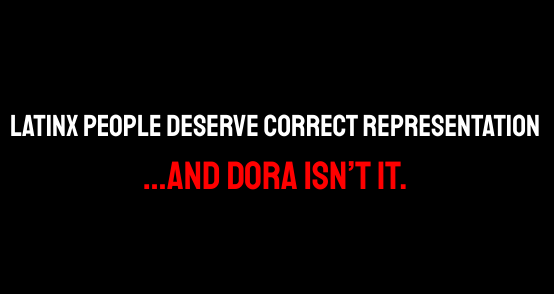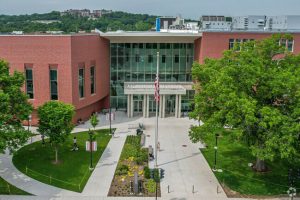LatinX People Deserve Correct Representation…and Dora Isn’t It

June 6, 2023
In the children’s TV show “Dora the Explorer”, a girl lives in the middle of a rainforest, talks to a monkey, and speaks a confusing mix of English and Spanish. Even though “Dora the Explorer” is stereotypical, it is one of the only high-income TV shows that features a LatinX protagonist and introduces Latin culture to international audiences. The popular TV show has a huge impact on people around the world, but sometimes that is the wrong impact. The problem is that LatinX representation in media, society, and even classrooms is small and sometimes stereotypical. By continuing the idea that all LatinX people look, live and act the same, all that is accomplished is giving misinformation to audiences around the world.
Nobody’s Life Is The Same
Latin America is a big place. Composed of 33 countries and nearly 700 million people, the region has immense diversity of geography, culture, language, and race. For example, the dialect and cultural practices of Cubans living in the Caribbean differ from that of Chileans living in the Andes mountains. However, in the US, we tend to have one image of what it means to be LatinX. We tend to picture someone from Mexico, with a particular skin tone and particular traditions. And while Mexicans deserve proper representation, so does anyone else who falls under the label of LatinX. The truth is, Latino’s come in all colors and from all walks of life. When we fail to understand and appreciate that, we create barriers and reinforce stereotypes.
LatinX Representation in Media is Small and Struggling to Grow.
In the television and movie media industry, LatinX representation is incredibly small, taking into account that, according to UCLA, LatinX people make up 19% of the U.S. population (as of 2021). The Los Angeles Times states that “even at the 2017 peak, Latino actors held only 6.2% of roles — despite making up 18.1% of the U.S. population that same year, according to the U.S. Census Bureau.” LatinX people making up close to 20% of the U.S population (in 2017) and then having less than 10% of roles is concerning. Having fewer LatinX actors in the industry also means that LatinX representation will be tremendously small. The LA Times has also stated that “during the period examined by The Times, Latinos have been consistently underrepresented in broadcast, cable and digital television alike.”, further emphasizing the point that LatinX people are being poorly represented in many forms of media. According to a GAO 2021 Study, CNN said that “the population of Latinos in the media industry increased by 1% from 2010 to 2019…”. Even if this increase does show signs of progress and change, we can not ignore that this increase is tremendously small, and continues to prove that LatinX representation in the media has been struggling to grow. Since LatinX people are already so underrepresented in the media, people that are not the “stereotypical LatinX” or don’t “look LatinX” are even more so. It is a known fact that media is one of the only ways, for some people, to learn about international cultures, traditions, foods, and living circumstances on a day-to-day basis. People receiving misinformation about other cultures could and does cause stereotypes to continue forming, halting growth in this area.
Additionally to this, many misconceptions are actually in the script of the movie. For instance, the world famous movie Encanto might have done an incredible job at spotlighting Colombian culture and traditions, but like several films that include LatinX characters, the movie showcased a family who lived in the middle of a rainforest. There are some Latin American people who live in very rural areas or in parts of the Amazon Rainforest, however, many and most Latin American people live in cities or urban areas. Other productions in this industry, such as the Dora the Explorer franchise also fuel this misconception by having a protagonist who, again, lives in the middle of a tropical forest. The troubling thing is that many viewers of these films and TV shows are young who are learning and absorbing this misinformation. Since the generations growing up with these shows are the generations of the future, giving this mistaken information to them will only make for an uninformed future with new barriers, sadly replacing what we are trying to overcome today.
Diversity in Schools Has Been An Addressed Issue, But Is It Enough?
Diversity is something lots of schools like OMS strive to achieve. Although the progress is slow, it is happening. From little things like changing math problem names from “John” to “Juan” to big things like creating groups where the school community can talk about issues, we’ve definitely grown. Yet, what many people fail to realize is that the people schools are representing in schools do not describe the whole race or ethnicity they belong to, yet the schools address it as such. Take math problems, for example. Teachers and creators of these problems try to include “LatinX” names such as “Juan”, “Sofia”, or “Manuel” but, by doing this, they are ignoring the thousands of people who are LatinX but don’t have a “LatinX name”. By using stereotypical “LatinX names” people are also fueling the misconception that all LatinX people are the same.
Homes Shouldn’t Have A Stereotype: The Common Misconception
A common misconception about Latin America is that everyone lives in rural areas. While some Latin Americans do live in small villages, about 80% of people in Latin America live in cities or other urban areas. Take Argentina, for example. Buenos Aires is a bustling, modern city with tall buildings and universities. The city closely resembles Boston or any other major American city. Countries like Argentina and Peru are just as architecturally and technologically advanced as the English speaking world. Across Latin America are large cities boasting skyscrapers and impressive cultural districts. The idea that all LatinX people live in small, impoverished communities is yet another harmful stereotype aimed at Latin Americans
What You Can Do
The issue is that the list keeps growing. Incorrect representation happens everywhere, and not just with the LatinX community. For another example of this, look at Africa. The first thing you imagine is a cheetah roaming the savannah or possibly a part of The Lion King, not the concrete buildings and cars found in the continent’s cities. While, as previously stated, it is important to respect and give proper representation to those who do live in these circumstances or have the particular skin tone or traditions society imagines a certain group having – either LatinX or European or Asian- we must also acknowledge the thousands, if not millions, of people who don’t.
So what can you do to help end this era of misconceptions? First, it’s important to acknowledge that this isn’t simply going to happen overnight. Like any movement in the world, it takes time and patience to make things change. You can make your mark and help, however, by doing your best to understand the diversity –in all aspects of life– there are in the world. People aren’t the same just because they share an ethnicity. While they may have some experiences in common, such as food or holiday traditions, not one person will look, act, or live in the exact same way as someone else.








Tea • Jun 7, 2023 at 3:45 pm
That’s amazing